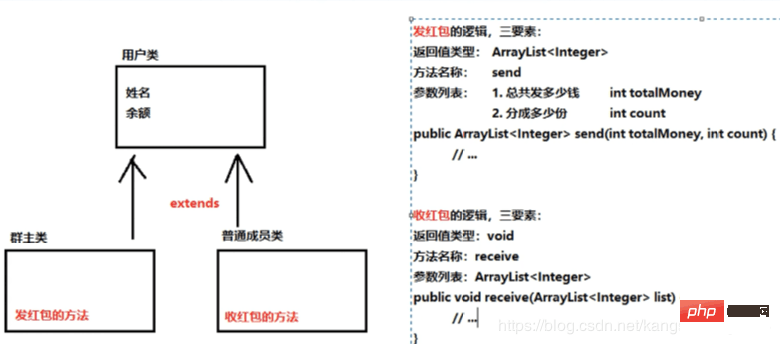
[Related learning recommendations: java basic tutorial]
Insert here Picture description
is divided into three categories. One parent category puts the amount and name in the parent category. Then create two new classes, namely the group main class and the ordinary member class. The group leader class has a method for sending red envelopes, and the ordinary member class has a method for receiving red envelopes. That is to say, only the group leader can send red envelopes, and ordinary members can only receive red envelopes. 
package cn.itcast.day09.demo14;public class User {
private String name;//姓名
private int money;//余额
public User() {
}
public User(String name, int money) {
this.name = name;
this.money = money;
}
//显示余额
public void show(){
System.out.println("我叫"+name+",我有多少钱;"+money);
}
public String getName() {
return name;
}
public void setName(String name) {
this.name = name;
}
public int getMoney() {
return money;
}
public void setMoney(int money) {
this.money = money;
}}
package cn.itcast.day09.demo14;import cn.itcast.day09.demo04.Arraylis;import java.util.ArrayList;public class Manager extends User {
public Manager(){
}
public Manager(String name, int money) {
super(name, money);
}
//发红包方法
public ArrayList send(int totalMoney,int count){
//首先需要一个集合,用来存储若干个红包金额
ArrayList redList=new ArrayList<>();
//首先看下群主自己有多少钱
int LeftMoney=super.getMoney();//获取群主当前余额
//判断群主余额是否充足
if(totalMoney>LeftMoney){
System.out.println("余额不足");
return redList;//返回空集合
}
//扣钱,更新余额。
//公式:最新余额=上次余额-发的钱
super.setMoney(LeftMoney-totalMoney);
//发红包需要平均拆分成为count份
int avg=totalMoney/count;
int mod=totalMoney %count;//余数,也就是零头
//下面把红包一个一个放到集合当中
for (int i = 0; i < count-1; i++) {
redList.add(avg);
//除不开的零头,抱在最后一个红包当中
/*if(i==count-1){
redList.add(avg+mod);
}*/
}
int last=(avg+mod);
//除不开的零头,抱在最后一个红包当中
redList.add(last);
return redList;
}}
package cn.itcast.day09.demo14;import java.util.ArrayList;import java.util.Random;//普通成员public class Member extends User{
public Member() {
}
public Member(String name, int money) {
super(name, money);
}
//收红包的方法
public void recive(ArrayList list){
//从多个红包当中随便抽取一个,给自己
//随机获取一个list集合当中的随机编号
int index=new Random().nextInt(list.size());
//根据索引,从集合当中删除,并且得到被删除的红包给自己。
int delta=list.remove(index);
//当前成员本来有多少钱
int money=super.getMoney();
//从新设置余额
super.setMoney(money+delta);
}}
package cn.itcast.day09.demo14;import java.util.ArrayList;public class MainRedPacket {
public static void main(String[] args) {
Manager manager=new Manager("群主",100);
Member one=new Member("成员A",0);
Member two=new Member("成员B",0);
Member three=new Member("成员C",0);
manager.show();
one.show();
two.show();
three.show();
System.out.println("=================================");
ArrayList redList=manager.send(20,3);
//三个普通成员收红包
one.recive(redList);
two.recive(redList);
three.recive(redList);
//群主最新余额
manager.show();
//成员最新余额
one.show();
two.show();
three.show();
}}

Related learning recommendations: Programming video
The above is the detailed content of Inheritance exercise of Java red envelope example. For more information, please follow other related articles on the PHP Chinese website!